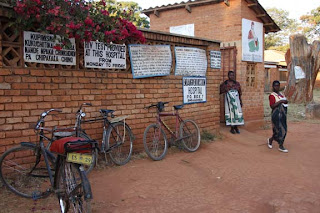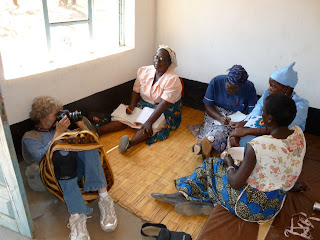
1 July, 2008, Monday
Where to begin? Chapel had already begun by the time we arrived at 7:05 AM. Mostly in Tumbuku. Some scripture reading, some extemporaneous exegesis by the sounds of it, a choral selection, sharing of concerns, announcements, a hymn and a benediction.
The Embangweni Mission hospital compound consists of several dozen terracotta-brick buildings and outer buildings surrounded by a terracotta-brick wall. Although the staff have told the community they need to keep the chickens out, there always seem to be a few hens clucking about on the grounds.
Officially, the catchment area is 100,000 people. Unofficially it's closer to 150,000.
Currently, Embangweni has about 130 beds plus mats for about 60 expectant mothers. Each inpatient, however, is typically accompanied by at least one and often two or three relatives. On average, the hospital has about 4500 to 5000 inpatient admissions each year and three times as many outpatient visits. That's not counting all the folks seen by the health centers and the mobile clinics.
Being admitted to a hospital alone is practically unheard of. For one thing, there is no facility to serve meals, so relatives bring food and water (there is a bore hole on the compound). Nurses hand over pills to each patient's caregiver or guardian and watch as the medicine is swallowed with water drawn by the caregiver. As odd as the system seems, it works. Given the personnel shortage, it would be criminal to try to keep friends and relatives out.
Its hospital policy to let one guardian sleep on the floor next to each patient. Others sleep outside the compound in the guardian shelter. Moms sleep with their children in the beds on the pediatric ward. Children six and up are admitted to the adult wards—which isn't ideal and the Embangweni staff know it. There are plans for a new ward for kids 6-to-13 years old—provided funding comes through, etc.
There are four main wards--female ward, male ward, pediatric ward and maternity—and the operating theater which is centrally located. At first glance, the wards seem practically deserted. In fact, everyone—family, friends and patients—are outside on the grounds, enjoying the winter sun. Only the very sickest remain inside.
In total, there are about 200 staff members employed by the hospital, including maintenance crews, laundry teams, drivers, ward maids, data clerks, the accounting team, nurses, clinical officers (sort of like physicians assistants or nurse practitioners), one physician, one matron and one hospital administrator.
Embangweni is a mission hospital—part of the Church Health Association of Malawi, which provides about 40% of Malawi's health care. There is one missionary here from the U.S.—Martha Sommers, who is a family physician—but she is not in charge. That is the job of the medical officer in charge. Right now Smith Mpepo, a clinical officer, is the acting officer in charge. The hospital is hoping a more permanent medical officer in charge will be arriving soon.
As for the rest, Mrs. Kamanga is the hospital administrator. She seems quite formidable—which is important when you're trying to prise amoxicillin or other drugs out of the government's Central Medical Stores. But she also has a wonderful laugh and a generous heart.
Am struck by the enormous size of the trees all around the compound. Some are 80-to-100 feet tall and look for all the world like the live oaks around the Rice campus in Houston. Several 10-to12 foot tall red and white poinsettias here and there and some enormous bougainvillea. Mango trees line several alleys. Not the sort of thing I had expected to see. But speaks to the generations of women and men that have invested in this place. Begun as a dispensary in 1902. Became a rural hospital in 1926.
Reminded me of something I heard from Leon Kintaudi, who was named one of TIME's Global Health heroes in 2005. We were talking about time frames—five-year programs and the like. He argued for a much longer horizon. You have to do things now in order to make a difference 100 years from now, he said.
(NB: This post was written on site in rural northern Malawi and posted now that I again have internet access.)







